
|
Greatest Courtroom Dramas 1950s |
(chronological by film title) Introduction | 1920s-1930s | 1940s | 1950s | 1960s | 1970s | 1980s | 1990s | 2000s | 2010s |
(chronological by title) |
|||||||||||||||||
| Film Title/Year/Director/Length/Studio, Academy Awards, Brief Description | |||||||||||||||||
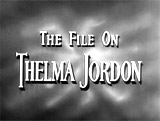
|
The File on Thelma Jordon (1950) The film noirish story centered around mysterious, duplicitous and treacherous femme fatale Thelma Jordon (Barbara Stanwyck) - as evidenced by the film's tagline: "...SHE'LL LIE...KILL OR KISS HER WAY OUT OF ANYTHING!" Thelma captured the emotionally-dependent heart of unhappily-married assistant District Attorney Cleve Marshall (Wendell Cory). Cleve's wife Pamela (Joan Tetzel) was more loyal to her wealthy father, and she constantly criticized him, pushing him to heavy drinking. Thelma chose Cleve as the duped fall-guy when she came to the office of chief investigator Miles Scott (Paul Kelly) to report robberies at her home. She engaged in an adulterous and illicit (but genuine) love affair with Cleve, telling him: "Maybe I'm just a dame and didn't know it." She had even confessed to him, falsely, that she was lovelessly married and recently separated from shady jewel thief Tony Laredo (Richard Rober) - when in fact they had planned the crimes together. The misguided and self-deluding "fall guy" DA threw aside his family, future, and honor and helped to defend Thelma after her wealthy Aunt Vera Edwards (Gertrude Hoffman) was murdered. DA Cleve helped Thelma to reconstruct an 'untouched' version of the crime scene, so that neither of them would be suspected of foul play for tampering with evidence. Thelma claimed to Cleve that Tony committed the murder during the robbery of her aunt's valuable emerald necklace, and made it look like an outside job. In reality, Thelma was the cold-blooded, calculating murderess. There was also suspicion about an unseen accomplice dubbed "Mr. X" (Cleve himself), who had assisted Thelma. Verdict: Thelma became a prime suspect - she was charged for the murder (her Aunt's recently-rewritten will in her favor was a major factor). Love-struck DA Cleve took up the prosecution on her behalf, quietly hired defense attorney Kingsley Willis (Stanley Ridges) for Thelma, and manipulated the case to her favor. He circumvented revealed evidence of a dark life of blackmail, gambling, and relationship with her husband-partner-in-crime Tony, and she was found not guilty. After a post-trial rendezvous of Thelma with Tony, the couple planned to flee and live off her Aunt's inheritance. When Cleve arrived to be with Thelma, she told him that Tony had reappeared from Chicago for her ("I've always loved him...You must have known it, except you didn't want to know"). She admitted that Cleve had been set up to help defend her ("You were the fall guy, Cleve, right from the beginning"), and that she had killed Vera ("I'd like to say I didn't intend to kill her, but when you have a gun, you always intend if you have to"). After Tony knocked out Cleve from behind, Tony and Thelma fled together to go "as far away as possible." She struggled with accomplice Tony as he drove, trying to injure him with a burning-hot dashboard cigarette lighter. He died when their car crashed over a cliff and caught fire, while Thelma was hospitalized. During her deathbed scene, she made a full confession to Miles, but refused to identify "Mr. X." As she expired, she told Cleve: "You don't suppose they could just let half of me die?" Miles realized that Cleve was the mysterious "Mr. X." |

|
|||||||||||||||
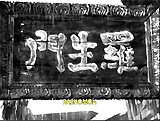
|
Rashomon (1950, Jp.) This multi-layered, cinematic, landmark masterpiece was about the nature of truth and the shaping of perceptions from different perspectives. It replayed (in flashback) the same crime story multiple times from different characters' eyes as they told incompatible, contradictory tales of the same mysterious 'rape' and murder in the woods in 12th century feudal Japan. The film opened under the shelter of Rashomon (the ruined South gate to modern day Kyoto). Woodcutter Kikori (Takashi Shimura) told a "strange" and "horrible" story (from three days earlier) to a commoner (Kichijiro Ueda) and temple priest Tabi Hōshi (Minoru Chiaki). He had discovered a murdered samurai nobleman while he was in the woods - he first found four pieces of evidence (a woman's reed hat with veil, a samurai's cap, a cut-up piece of rope, and an amulet case) before he found the body. He reported his story to the police along with the priest, who reported that he saw the samurai traveling with his wife the day of the murder (or suicide). Then, they listened to the arrested and captured bandit who was injured (after being thrown from the samurai's stolen horse). The order of the testimonial stories was as follows:
Verdict: In the epilogue, it was revealed that the reason the woodcutter was reluctant to testify was because he was also "a bandit" who had taken the pearl-inlaid dagger from the murder scene. However, he was redeemed in the eyes of the suspicious priest when the woodcutter revealed that his motives were not dishonest or selfish. He decided to adopt an abandoned baby - although he already had a family of six children: ("Another one wouldn't make a difference"). |
 (l to r): Priest, Commoner, Woodcutter  The Bandit Watched the Couple  Wife's Face First Revealed to Bandit  The Medium |
|||||||||||||||
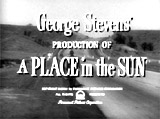
|
A Place in the Sun (1951) A star-crossed melodramatic romance (and social drama), based on Theodore Dreiser's 1925 novel "An American Tragedy." Low-born, ambitious George Eastman (Montgomery Clift) hitched a ride to his distant Uncle Charles Eastman's (Herbert Heyes) place, where he was given an assembly-line bathing-suit factory job. The poor boy was entranced and infatuated by the snobbish, beautiful, well-bred rich socialite Angela Vickers (Elizabeth Taylor) and they fell in starry-eyed love. He also dated and impregnated poor, lower-class co-worker Alice Tripp (Shelley Winters), after which a doctor refused to terminate her unwanted pregnancy (the term abortion was not used). Using blackmail, she also threatened to reveal their relationship and pregnancy, and even mentioned committing suicide. On Labor Day weekend at the Vickers' lakeside home, Alice arrived to confront George, and insisted that they go to the county clerk's office to get married - but it was closed for the holiday. During a rowboat ride with Alice on Loon Lake that dark night, George contemplated, planned and willed (if not actually committed) the murder of his fiancee, by overturning the boat and letting her drown. Then, in a twist of fate, she accidentally fell in when the boat capsized, and she drowned, and he was unable (or unwilling) to save her. Verdict: George faced murder charges and went to trial. He intended to murder Alice, but there were no witnesses that he actually did. There was only strong circumstantial evidence against him. The relentless District Attorney R. Frank Marlowe (Raymond Burr, TV's future Perry Mason) devastated George on the stand. He even re-enacted the rowboat death in the courtroom, while George failed to credibly answer questions and help to reconstruct the drowning. The most dramatic moment was when Marlowe struck the oar across the boat, implying that George had struck Alice and caused her to fall into the water. George was convicted - and fell from his 'place in the sun' when executed (by the electric chair). |

|
|||||||||||||||
I Confess (1953) In this film-noirish crime thriller/drama, humble Canadian (Quebec) priest Father Michael William Logan (Montgomery Clift), an ex-war hero, listened in the church booth to the confidential confessions of his church's live-in handyman/caretaker Otto Keller (O.E. Hasse), a German refugee. Keller admitted that he had disguised himself as a priest, and in a failed robbery attempt killed lawyer Villette (Ovila Légaré), where he served as part-time gardener. Keller also told his wife Alma (Dolly Haas), the church's housekeeper about his crime. Innocent, martyr-like Father Logan was implicated and became a prime suspect, after two schoolgirls testified that they saw a priestly figure leaving Villette's home at the time of the crime. Father Logan was unwilling to reveal his knowlege or his whereabouts (at the time of the murder) to anyone, claiming rigid sanctity known as 'priest-penitent privilege.' He also refused to tell anything to Police Inspector Larrue (Karl Malden). During the investigation, Logan's pre-priesthood lover Ruth Grandfort (Anne Baxter), married to respected Parliament member Pierre Grandfort (Roger Dann), attempted to help by providing Logan with an alibi. She stated that she was meeting with Logan just before the time of Villette's murder. They were discussing Villette's blackmailing attempt. [Note: About five years earlier, seen in flashback, Villette scandalously saw the married Ruth and Logan spend the night together during a storm - although they were chaste - and now threatened to divulge this information.] Police turned around her testimony, concluding that Logan had a clear motive to kill Villette. They also discovered (planted) bloody priest's robes in the bottom of Logan's chest, with a blood type that matched Villette's. Verdict: Father Logan was accused of the murder and went to trial, denying any involvement in the murder, while not revealing anything about Keller's confession. Prosecutor Willie Robertson (Brian Aherne) insinuated (unfairly) that Logan and Ruth were having an ongoing affair. The jury ruled that Logan was not guilty, because of insufficient evidence. As Logan left the courtroom, the angry, suspicious and hostile crowd believed he was guilty. Knowing the truth of the murderer's identity, Keller's wife Alma attempted to tell a policeman that her husband was the real killer - she was silenced by a bullet from the panic-stricken Keller. The police went to arrest Keller, cornered in a hotel ballroom. The killer incriminated himself when he accused Logan of hypocrisy - by telling the police about his confession. When Father Logan approached Keller to plead with him to surrender, Keller attempted to shoot Logan, but was killed by a police sniper. |
|||||||||||||||||
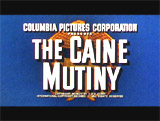
|
The Caine Mutiny
(1954) Young Princeton graduate ensign Willie Keith (Robert Francis) told how he was assigned to a dilapidated and rusty minesweeper named the Caine, sternly captained by newly-appointed Lt. Commander Philip Queeg (Humphrey Bogart), a veteran of almost eight years of service. The eccentric Queeg reprimanded the crew for messy shirttails, haircuts, and other petty things, and soon it was apparent he might be paranoid and mentally unbalanced (evidenced by his rolling silver metal balls in one shaky hand). The captain began to demonstrate how incompetent he was, during a beach-landing incident in which he was dubbed "Old Yellowstain." The question arose: Could the naval officers take control of the ship, without being accused of mutiny? The last straw was Queeg's mis-treatment of an incident involving a quart of leftover strawberries in the officer's mess, and when Queen mismanaged the ship during a typhoon and executive officer Lt. Steve Maryk (Van Johnson) stepped in and took charge. Maryk and Keith were both court-martialed for mutiny, to be defended by reluctant counselor Barney Greenwald (Jose Ferrer). Cynical Lt. Tom Keefer (Fred MacMurray), the true instigator of the mutiny idea, testified that taking the ship from Queeg was in error, to save himself on the witness stand. Verdict: The prosecution's case faltered when Queeg was cross-examined, and he became frantic, paranoid, and blamed everyone for the Caine's problems, while nervously rolling the clanking steel balls in his hand. The two officers were acquitted. |
   |
|||||||||||||||
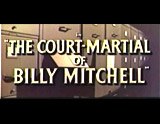
|
The Court-Martial of Billy Mitchell (1955) This biographical (biopic) war docu-drama, a true story (although containing a number of fictionalized elements), was set in the mid-1920s. Stubborn but dedicated military airman Gen. William "Billy" Mitchell (Gary Cooper), a WWI hero, was a prophetic visionary who proposed the expansion of airpower during future military combat, but his crusading recommendations to the US War Department were continually overlooked and ignored. With his aircraft expertise and uncompromising nature, he argued for better aircraft maintenance, and the upgrading the fleet of airplanes left over from WWI. To make a firm political statement, in July of 1921, he deliberately violated military rules during a test of aircraft at an army test site off the coast of Virginia by using heavier bombs (above the 1,000 pound limit) and flying at a lower altitude of 2,000 feet (below the 5,000 foot required level). He proved his statement that battleships could be neutralized during war with air power by sinking the ex-German World War I battleship Ostfriesland. However, he was reprimanded for his disobedience. In 1925, he was demoted to Colonel and sent to a clerical army post in Fort Sam Houston (San Antonio, Texas). Meanwhile, outdated planes were continually crashing (six aircraft crashed on their way from California to Arizona), and Mitchell lost some of his closest friends, including Lt. Cmdr. Zachary "Zack" Lansdowne (Jack Lord) and 13 other crew members who died in a senseless tragedy over Ohio during a 27-city publicity junket on the USS Shenandoah airship-dirigible. To publicize the problem and complain, Mitchell lobbied for a press conference, and accused the Navy and War Departments of criminal negligence, incompetence and treasonous administration. Predictably, he was court-martialed. The "Court-Martial" Trial touted in the film's title began at the 70 minute mark of the 100 minute-long film. Illinois Congressman Frank Reid (Ralph Bellamy) and military-appointed attorney Lt. Colonel White (James Daly) defended Mitchell, while the prosecutor was Colonel Moreland (Fred Clark), and the presiding judge was Maj. Gen. James Guthrie (Charles Bickford). None of the military officers involved in the case had Air Corps experience. Verdict: Court-martialed Mitchell was tried for breaking Articles 133 and 134 of the Uniform Code of Military Justice: conduct unbecoming an officer, and conduct that discredited the military. Congressman Reid was stymied when his requests to call witnesses to speak on Mitchell's behalf were denied. He asked Mitchell to sign a paper to withdraw his criticisms in exchange for reestablishing himself as an Army officer, but he refused. Mitchell had definitely disobeyed the articles and his commanding officers, but questions were raised: why, and were his accusations justified? The hearing began to turn in Mitchell's favor when previously-denied witnesses were allowed to testify, including WWI ace Capt. Eddie Rickenbacker (Tom McKee), Major Carl Spaatz (Steve Roberts), Major H. H. Arnold (Robert Brubaker), and Congressman Fiorello LaGuardia (Phil Arnold) (the future mayor of NYC). Lansdowne's widow Margaret (Elizabeth Montgomery in her film debut) testified that her husband's aircraft was a death trap. When Mitchell took the stand, he was cross-examined by sharp special prosecutor Major Allen Guillion (Rod Steiger). While also suffering from a malaria attack, he stood up to the nasty, skilled prosecutor, arguing that with the current state of the Air-Force, the US Navy at Pearl Harbor could easily be attacked (as it was years later). At the conclusion of the trial, Mitchell was convicted of insubordination, and suspended from active duty for five years without pay. |

|
|||||||||||||||

|
Trial (1955) Director Mark Robson's and MGM's courtroom crime drama featured themes of bigotry, hypocrisy and political extremism. It told about a controversial trial held after an Hispanic boy was arrested for the death of a Caucasian female, in a lynch-mob atmosphere of anti-ethnic race prejudice in the community, and during the growth of Communist special interests. In the film's pre-title credits sequence during a nighttime scene at a crowded San Juno Village, CA private beach (limited to residents only), after a loud scream, 17 year-old Hispanic teenager Angel Chavez (Rafael Campos) was found by a game warden standing over a deceased female, later identified as Marie Wiltse. It was the summer of 1947. At San Juno State University, five-year war veteran and idealistic, clean-cut university law instructor David Blake (Glenn Ford) was being threatened by Dean George (Everett Glass) with the non-renewal of his teaching contract, for lacking legal courtroom trial experience. Blake went searching for work in a law office - he visited the small law-firm of street-smart shark-attorney Barney Castle (Arthur Kennedy), assisted by his competent and smart legal secretary Abbe Nyle (Dorothy McGuire). He was offered a job if Castle could take on a case regarding a client that was currently in jail. The accused boy was being held in jail by racist courthouse jail-sheriff A. A. "Fats" Sanders (Robert Middleton) and visited by his mother Consuela (Katy Jurado). Chavez admitted that he had trespassed onto the private beach, and had become acquainted with the victim who was a student in his HS. He claimed that she willingly kissed him and they started to make out, but then she got scared and ran away. He found her dead body up a flight of stairs and screamed for help. Abbe mentioned that the girl was known to have suffered from recurring rheumatic fever. The boy had to be charged on suspicion of statutory rape (due to Marie being under-age) and first-degree "felony murder." Blake was hired by Castle as a defense lawyer to take the pro-bono Chavez case known as State vs. Chavez. The DA prosecutor was John "Jack" Armstrong (John Hodiak). A group of disgruntled townspeople, led by aristocratic and bigoted real estate mogul Ralph Castillo (John Hoyt) and long-time Ku Klux Klan member Cap Grant (Paul Guilfoyle), sought vengeance by marching to the jail. Their objective was to break the boy out of jail and execute him, but they were persuaded to leave by "Fats" who promised them a 'legal hanging.' During pre-trial preparations, Blake began to realize that the shady Castle had an ulterior motive. He clearly had no desire for Angel to be acquitted, and was in fact sabotaging the case. He was also manipulating and controlling the boy's mother Consuela Chavez. To raise funds for the defense, Castle organized a New York City fund-raising rally sponsored by the All Peoples Party (a Communist front). When the trial opened, it was presided over by black Judge Theodore Motley (Juano Hernandez); Blake suspected the black judge had been chosen due to pressure from town bigots who wanted only the appearance of a fair trial. The original jury panel was dismissed because of charges of jury tampering - the prospective jurors had been visited in their homes and interrogated (and intimidated) by city detectives beforehand. Blake was flown back to NYC to attend the rally, where he objected to Castle taking money from Communist groups and labor unions ("Half of 'em are a bunch of Communists!... I don't want that kind of money"). After tearing up a prepared speech, and about to give his own anti-Communist speech, Blake's microphone was cut and he was drowned out by a loud brass band. Blake realized that he had walked into a "trap" and was being used and duped by the prejudiced Castle for propagandistic purposes (a guilty verdict would bring continued racial unrest and promote fund-raising and support for his own Communist-backed organization). Verdict: After three weeks, a jury was finally selected. During the trial's opening statements, the DA called for the death penalty. The DA's first witness was Marie's physician from childhood, Dr. Johannes Schacter (Richard Gaines), who testified that Marie died of "violent exertion" to her heart, due to a long history of rheumatic fever. Blake's strategy was based on solid, rigorous and aggressive cross-examination to rebut the prosecution's case. He revealed that the victim was at risk of dying at any time anyway, and she was found halfway up a long flight of stairs. The atmosphere of the trial was tense, due to the continuing protests of white supremacists and other lynch mob members who were rallying to put the Latino Chavez boy away. Even Castle was counting on Angel's testimony to be self-convicting, in order to ruin any chances of acquittal (and to make Chavez a martyr for his political leftist cause supporting a "new world" order). As it turned out, Angel's testimony was self-damning, vague and not very convincing. The jury ruled against Angel and he was convicted of the crime of felony murder. Blake sought to set up an immediate appeal, but was fired by Castle to prevent him from participating in the sentencing hearing the next day. At the sentencing, Castle proposed a mandatory death penalty. Blake burst into the court and asked to speak during the sentencing with an "amicus" (friend of the court) ruling by the Judge. The race-baiting Castle strenuously objected and zealously denounced the Judge for "outrageous prejudicial conduct," and derogatorily called him "a handkerchief head" and "an Uncle Tom!" Blake delivered an emotional speech to denounce the bigoted and prejudiced Castle for using everyone as his own pawns, and for supporting Angel's execution in order to advance support for his own Communist interests even before the trial began. In the film's happy ending, Blake argued for an obscure code statute requiring that the youthful juvenile offender be sent for a short term to the state's industrial reform school;. Even DA Armstrong added that the defendant should receive an "indeterminate sentence" rather than the death penalty. The Judge accepted Blake's argument for "justice" with a "much fairer sentence." The film concluded with the Judge sentencing the out-of-order Castle to 30 days in the county jail for contempt of court due to his earlier outburst. |

|
|||||||||||||||

|
Beyond a Reasonable Doubt (1956) Fritz Lang's last American film was this film noirish crime drama about hubris and fate. It was mostly a polemic against capital punishment with its overly-contrived, concocted plot. In summary, a novelist planted clues to implicate and frame himself (with circumstantial evidence) in an unsolved murder - making himself a 'guinea pig' as a way to protest against the unfairness of the death penalty. Fate intervened, and he found himself trapped in his own undoing - the taglines stated: "Put them all together they spell M-U-R-D-E-R !" and "What kind of man would frame himself for MURDER?" Midwest novel writer Tom Garrett (Dana Andrews), engaged to marry wealthy socialite Susan Spencer (Joan Fontaine), volunteered to become the fall guy in an implausible attempt to try to eliminate capital punishment (the electric chair). Susan's wealthy father Austin Spencer (Sidney Blackmer), a crusading liberal newspaper publisher, schemed with Garrett to plant clues to prove his point about the unfair justice system - that a completely-innocent person could be implicated as a murderer in an unsolved case with no suspects - the strangulation murder of burlesque dancer Patty Gray. It was predicted that ambitious DA Roy Thompson (Philip Bourneuf) would convict the suspect and sentence him to death - thereby allowing Austin to reveal the situation, reverse things, and win points for his editorial point of view. The risky plan would also provide Garrett with new material for his next best-seller. The half-baked scheme was initiated with the planting of evidence (and photographs of every part of the plan to prove Garrett's innocence): Patty's silk stocking in Garrett's glove compartment, and Garrett's inscribed cigarette lighter was deposited at the scene of the crime. [Of course, they broke the law by lying to police and planting phony evidence.] Garrett also began dating Patty's stripper friend Dolly Moore (Barbara Nichols). As predicted, Garrett was arrested by Lieutenant Kennedy (Ed Binns) when he started to assault Dolly. Verdict: During the trial, the planted circumstantial evidence presented by the DA (and assistant DA Bob Hale (Arthur Franz), Susan's ex-boyfriend) was overwhelming against Garrett. The defense lawyer for Garrett, who was incapable of mounting a strong case, was Jonathan Wilson (Shepperd Strudwick). Even Garrett's coincidental $3,000 withdrawal of funds to buy an engagement ring for Susan was used against him. Just before the jury verdict was brought, Austin died in a fiery automobile crash - and an envelope of all of the photographs and proof to help exonerate Garrett were burned. Wilson was told of the secret plotting and deception, but when the scheme was revealed to Thompson, he was not interested in bending. However, at the last minute, a letter written by Austin about the entire scheme was discovered, and Thompson then agreed to seek a pardon from the governor. In the twisty plot with a dramatic climax, Garrett gave himself away. He unconsciously referred to the dead victim Patty as Emma - her former name - and implicated himself as the actual killer. Garrett confessed to Susan that Patty/Emma was in a loveless marriage to him and wouldn't seek a divorce, so he murdered her, as a way to further his romance with Susan. Once the governor was notified, he declined signing the pardon, and Garrett was delegated to death row. |

|
|||||||||||||||
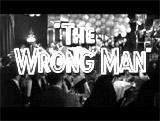
|
The Wrong Man (1956) In this stark, film-noirish, documentary-styled crime drama, Stork Club string bass player and devoted family man Christopher Emmanuel "Manny" Balestrero (Henry Fonda), living in the Jackson Heights (Queens) neighborhood of New York City, was mistakenly identified as a suspect for robberies (at gunpoint) at the Associated Life Insurance Company office - and police arrested him. He had visited the office to obtain a loan from wife Rose's (Vera Miles) policy, to pay for her expensive dental work. Detained and held for intense questioning for armed robbery without a lawyer (Manny called the grilling a "meatgrinder"), unusual coincidences caused police to believe that he was responsible for a string of robberies. The innocent 'everyman' Manny protested the charges, claiming he was "the wrong man." After being bailed out for $7,500 after a night in jail, inexperienced criminal attorney Frank D. O'Connor (Anthony Quayle) was hired to defend Manny. His alibi was that he was at a resort hotel with Rose during one of the robberies, but it couldn't be substantiated. Due to the stress of the case, Rose fell into depression, became totally apathetic, and was institutionalized in a mental hospital. Verdict: During the trial, Manny was convincingly prosecuted, although it was judged a mistrial due to a juror's remarks. Meanwhile, the real robber was caught - his face closely resembled Manny's. The case was dismissed. In the film's epilogue, Rose was eventually cured two years later, and the couple moved to Florida. |

|
|||||||||||||||
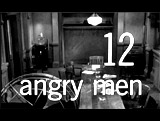
|
12 Angry Men (1957) In a courtroom after the trial, instructions by a Judge (Rudy Bond) were given to the jury, concerning the case of an 18 year-old, slum-dwelling Puerto Rican defendant (John Savoca), held on charges of murdering his abusive, ex-con father with a knife. He had been defended by a poorly-paid, inept public defender. The entire film consisted of the deliberations of twelve male individuals (each un-named but with a number) held in a swelteringly-hot, bare-walled claustrophobic jury room, punctuated by flashbacks about the case and trial. One female witness testified that through her bedroom window and a passing elevated train, she had seen the murder. Another elderly witness claimed he heard the defendant say: "I'll kill you" - after which he heard the body drop and saw the defendant running down the stairs. As evidence, the long switchblade murder weapon was similar to the one the defendant had purchased. On the witness stand, the defendant's alibi was weak - he said he was at the movies during the night before returning to the scene of the crime, but couldn't recall the movies that he had seen. The case required a unanimous vote ("beyond a reasonable doubt") of 12 jurors to convict, and to send the defendant with a mandatory death sentence to the electric chair. Verdict: After the first jury vote, it was eleven to one for conviction. Juror # 8 (Henry Fonda), an architect, was the sole doubting and dissenting vote. After considerable deliberations and discussion, including # 8's display of an identical switchblade knife he had bought, a second vote was taken - # 8 was joined by Juror # 9 (Joseph Sweeney) - and now it was ten to 2. Juror # 8 began to poke holes in the flimsy evidence, the inconsistent testimony of the unreliable witnesses, and the prejudices of some of the other jurors, especially Juror # 10 (Ed Begley). For one thing, the old male witness probably couldn't have heard the defendant yell at his father as the noisy six-car train passed on the tracks. And the elderly man, who was lame, couldn't have walked from his bedroom to his door in 15 seconds as he claimed. The woman who said she saw the crime through the passing train was not wearing her glasses. Eventually, revotes dwindled down the number of those calling for conviction. Only one Juror, # 3 (Lee J. Cobb) remained defiant, and he too changed his vote. The defendant was acquitted of the crime. |

|
|||||||||||||||

|
Paths of Glory
(1957) This classic, powerfully bleak, anti-war drama about the hypocrisy of militarism and power was based on Humphrey Cobb's factual novel. The film was an effective denouncement of self-seeking, pitiless WWI French military leaders whose strategy and mishandling of a failed mission were incomprehensible. In 1916 during horrendous trench warfare on the French front (filmed with realistic tracking shots) against the Germans, a vain and pompous French General Paul Mireau (George Macready) ordered his hapless group of soldiers to suicidally attack an obviously-impenetrable German stronghold, dubbed the Ant-Hill. Mireau had been promised a promotion - another military star - for his efforts by evil General George Broulard (Adolphe Menjou). The catastrophic attack was executed by infantry commander Colonel Dax (Kirk Douglas). When they predictably failed in the ill-conceived attack, Mireau angrily commanded his own artillery to fire on the 'cowardly' troops. As a cruel example to others, three blameless men were arbitrarily and randomly picked as scapegoats to stand trial and be court-martialed for cowardice. The three were: Corporal Philippe Paris (Ralph Meeker), Private Pierre Arnaud (Joseph Turkel), and Private Maurice Ferol (Timothy Carey). Verdict: Military commander and dissenting Army lawyer Colonel Dax, aware of the disgraceful cover-up and episode, volunteered to defend the condemned men. During the sham court-martial trial, held in a luxurious chateau, there were no prosecution witnesses, no indictment, and no stenographic record of the very unfair proceedings. After an unsuccessful yet eloquent defense by Colonel Dax, who claimed that the trial was a farce ("a mockery of all human justice"), the three faced execution by firing squad the next morning. Following the executions, Mireau was removed from command by Broulard, and the command job was offered to Dax - who refused to accept. |

|
|||||||||||||||
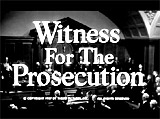
|
Witness for the Prosecution (1957) Co-writer and director Billy Wilder's brilliant film had crisp dialogue, a complicated and intriguing plot, unique characters and excellent acting performances. It was a convoluted, twisting courtroom mystery adapted from Agatha Christie's classic four-character short story "Traitor's Hands," first printed in 1925 in the British magazine Flynn's, and then published in the 1930s and 1940s in both the UK and US as "The Witness for the Prosecution." It then became a celebrated 1953 stage play and murder mystery (in London and on Broadway): It told about an aging, distinguished, near-retirement age London barrister Sir Wilfrid Robarts (Charles Laughton), with his overbearing housekeeper/nurse Miss Plimsoll (Elsa Lanchester, Laughton's real-life wife) tending to his near-failing health for a weak heart. The intelligently clever and incorrigible attorney was asked by solicitor Mr. Mayhew (Henry Daniell) to take on a perplexing case, the defense of the prime murder suspect - an unemployed, American expatriate inventor named Leonard Stephen Vole (Tyrone Power in his final film role). He was charged with the murder of wealthy, childless widow Emily Jane French (Norma Varden), in order to obtain her recently-changed willed inheritance (80,000 pounds). Verdict: The testimony -- and true identity -- of the mysterious, beautiful German-born 'wife' of the accused, Christine "Helm" Vole (Marlene Dietrich), held the key to solving the case involving marital infidelities and deceit. She was her husband's only alibi - but she could not, as the defendant's wife, be considered a credible witness. However, she WAS called as a 'witness for the prosecution' to damningly testify against him and cold-heartedly betray her husband. On the stand, she admitted that: (1) she wasn't really legally married to Leonard (and could therefore testify against him), (2) she was forced by him to provide a false alibi, and (3) her husband had admitted the murder to her, after returning home with blood on his clothes. When a mysterious Cockney woman (also Dietrich) called Sir Wilfrid claiming that she had surprise information to help his client, the film set up the twist ending. She offered to supply the barrister with love letters (so she could get rid of Leonard and be with Max) that the perjuring Christine had written to a mysterious lover named Max. When the trial resumed, Sir Wilfrid confronted Christine with the letters to prove that she had lied. Having proven Christine to be a liar and unreliable witness, Leonard was declared 'not guilty.' After Leonard had been acquitted, Christine revealed that she was disguised as the Cockney woman who had devised the ploy of love letters to get Vole acquitted. Only by being an entirely uncredible witness could she get her husband declared innocent. The defendant had obviously been guilty all along, and had committed the crime. He also declared that he was unfaithful and philandering with Diana (Ruta Lee), who arrived in the courtroom to run away with him. Then, with furious and jealous anger, Christine shockingly stabbed Leonard to death for his double-crossing unfaithfulness! This climactic murder was followed by Sir Wilfrid's classic line when he corrected his nurse Miss Plimsoll about the killing: "Killed him? She executed him." Sir Wilfrid would now serve as Christine's defense lawyer. |

|
|||||||||||||||

|
I Want to Live! (1958) A film-noirish, low-budget, gritty biographical (yet heavily fictionalized) crime drama (with an original rhythmic jazzy score) that was an indictment of capital punishment. The screenplay was based on magazine and newspaper articles, court transcripts, and personal letters from the imprisoned and condemned defendant. Non-violent petty criminal (burglary, forgery, perjury), prostitute ("party girl"), and drug addict Barbara Graham (Academy Award-winning Susan Hayward) was also associated with West Coast low-life, underworld figures in San Francisco's Tenderloin area. The street-wise seemingly tough female acted as a "shill" - bringing in unsuspecting men to be fleeced at a gambling parlor. Graham was charged by a grand jury with the brutal murder of crippled, 64 year-old widow Mrs. Mabel Monahan during a robbery attempt in her Burbank, CA home in March of 1953, along with three known criminal accomplices: Emmett Perkins (Philip Coolidge), John R. 'Jack' Santo (Lou Krugman), and Bruce King (James Philbrook). Reportedly, the murder victim had $100,000 hidden somewhere in her home, but wouldn't divulge where. Underground figure King was apprehended at the scene, turned state's evidence, and ratted on the location of Graham and her petty associates in Lynwood, CA. The three suspected murderers were now in custody. Although Graham was questioned thoroughly, she defiantly claimed her innocence, but her sordid past would cause her to be regarded as guilty from the start (without presumption of innocence). For the trial, she was defended by attorney Richard Tibrow (Gage Clarke). Verdict: During the trial, King had been granted immunity, and claimed that Graham was a partner in the crime (she was nicknamed "Bloody Babs"). She had no solid or credible alibi - it couldn't be proved that she was home with her shifty, drug-addicted bartender-husband Henry/Hank Graham (Wesley Lau) and young child on the evening of the crime. Wired undercover police detective Ben Miranda (Peter Breck) entrapped the desperate and anxious Graham (fearing the death penalty) into confessing, when she was falsely promised an alibi. She was convicted of the crime in 1954, and sentenced to death. During the torturously-long appeals process, she was represented by San Francisco reporter-newspaperman Ed Montgomery (Simon Oakland), and defended by psychologist Carl Palmberg (Theodore Bikel), who claimed she was anti-social, but not violent. Her loyal friend Peg (Virginia Vincent) also testified on Barbara's behalf. However, her verdict could not be overturned ultimately, and she was not able to obtain clemency from the governor. After a few last-minute stays of execution were exhausted, 31 year-old Graham - who still claimed she was innocent, was sent to San Quentin's gas chamber in the late-morning of June 3, 1955. The death scene was memorable. When strapping her in a chair, preparing the sulphuric acid chemicals (and cyanide pellets), and masking her, the prison guard added: "When you hear the pellets drop, count ten. Take a deep breath. It's easier that way." Graham quipped: "How do you know?" |

|
|||||||||||||||

|
Anatomy of a Murder (1959) Hot-tempered Army officer Lt. Frederick Manion (Ben Gazzara) was charged with the murder of the bartender/owner of Thunder Bay Inn, Barney Quill. Manion turned himself in after shooting and killing Quill, and was arrested for murder. Manion alleged that Quill had raped his attractive wife Laura (Lee Remick). Country-styled Paul "Pauly" Biegler (James Stewart), more interested in jazz piano and fishing than trying cases, was hired to represent and defend Manion. During questioning, the couple claimed that Quill beat and raped Laura - and afterwards, under an "irresistible impulse," calmly strode to the tavern an hour later and committed the crime. Was Manion legally sane or insane? The tough prosecutor was co-counsel and assistant DA Claude Dancer (George C. Scott), who tried to paint Laura as a trampy, provocative woman. There was a long debate about "lost panties" (allegedly torn off by Quill) - later verified by the inn manager Mary Pilant (Kathryn Grant), who found them in the laundry chute near Quill's room, and shockingly revealed that Quill was her father, and that she was his illegitimate daughter. Verdict: In the quick conclusion to the case, Manion was found not guilty (by reason of temporary insanity at the time of the shooting). He unexpectedly left town with Laura (who was seen crying) - with only a note for Biegler, explaining that he was seized by an "irresistible impulse" to leave. Evidence at the trailer park in the trash barrel suggested that Manion was a heavy gin drinker who beat Laura before they left (the reason for her tears). The film ended with a mystifying possibility that the Manions had duped everyone - it was highly probable that Laura's sexual encounter with Quill was consensual (and not rape) and that Manion had killed Quill out of drunken jealousy. |

|
|||||||||||||||

|
Compulsion (1959) This film-noirish biopic was a modified version of the Nathan Leopold-Richard Loeb case from the mid-1920s, when two 18 year-old killers, law students at the Univ. of Chicago, were defended by famed Clarence Darrow. Likewise in the film set in 1924, two University of Chicago law students, Judd Steiner (Dean Stockwell) and Arthur "Artie" Straus (Bradford Dillman) were both rich, spoiled, and elitist genuises, with a dominant-submissive relationship to each other - Artie was the bullying and sadistic one. [Note: There was also the strong possibility of a homosexual relationship, although that had to be avoided due to censorship of films at the time.] They kidnapped young Paulie Kessler as a thrill, as an attempt to commit the "perfect crime," and as a way to taunt law-enforcement. During the incident, Paulie was killed (by a blow to the head from a blunt instrument), and afterwards his body was drowned in a park. However, Steiner lost his glasses at the crime scene - a crucial piece of evidence. The case was helped by the investigation of their law school colleague Sid Brooks (Martin Milner), who worked part-time for the Globe newspaper. The two killers continued their crime spree - after Straus challenged Steiner to rape Sid's girlfriend Ruth Evans (Diane Varsi), although he didn't carry through with the sexual assault when Ruth reacted with compassion rather than resistance. A tough DA Henry Horn (E.G. Marshall) traced the glasses back to Steiner. The two made a detailed confession and blamed each other, before the case went to trial. Verdict: Legendary socialist lawyer Jonathan Wilk (Orson Welles) was hired by the defendants' wealthy parents to defend them. During the trial, Horn delivered an opening statement, which was followed by Wilk's shrewd change of the clients' plea to guilty, to eliminate trial by jury. He realized there was overwhelming evidence against his clients, that would assure them of a harsh punishment. For ten days, Wilk introduced psychological evidence to show how mentally ill the two remorseless defendants were, but not insane. He did not want to plead an insanity case (which would also require the jury). He wanted to plead their case solely before the judge. The film's most dramatic and flamboyant moments came during Wilk's closing argument (the longest true monologue in film history) - an eloquent diatribe against capital punishment ("I'm pleading for love"), when he stated that the barbaric practice should be ended. He conceded that his clients were guilty and made an impassioned plea against the state being able to execute the two youths regardless of the severity of their pre-meditated crime. The judge was persuaded - he sentenced the two to life imprisonment, plus 99 years. |
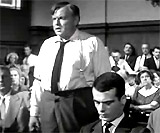
|
|||||||||||||||

|
Libel (1959, UK) The main characters in this drama about mistaken identity, war trauma and amnesia were Baronet Sir Mark Sebastian Loddon (Dirk Bogarde), Jeffrey Buckenham (Paul Massie), and Frank Welney (also Bogarde) - all three were POWs in a German WWII prison camp before escaping in the spring of 1945. [The film's main point of confusion was that one of the POW's had reportedly died or disappeared during/after the escape attempt.] Afterwards, Loddon (or was it Welney?) married his American sweetheart - Lady Margaret (Olivia de Havilland), and lived at his estate in Ingworth. In London fifteen years later, Canadian commercial pilot Buckenham saw a BBC telecast of Sir Mark Loddon conducting an interview at his 16th century Ingworth Hall estate. He believed that Loddon was a fraud or imposter, and printed an accusatory expose in the tabloid Daily Gazette, titled "Bogus Baronet - Fraud and Imposter". Buckenham claimed that Loddon had been replaced by Frank Welney. Lady Margaret urged her husband to sue both the Gazette and Buckenham for libel (false statements). The case would be judged by two collegial yet rival barristers: distinguished Sir Wilfred (Robert Morley) representing Loddon's libel lawsuit, while Buckenham's lawyer was Hubert Foxley (Wilfred Hyde White). Verdict: The lengthy, complex libel court case was difficult because the evidence seemed to support Buckenham's assertions, although Lady Margaret at first refused to doubt her husband. Sir Mark Loddon was unsure about his own identity - and because of their physical resemblances, Loddon and Welney were look-alikes. Both Loddon and Welney had missing parts of right hand fingers as well. And Loddon stuttered and suffered selective memory losses. Evidence kept alternating back and forth substantiating or disproving Sir Mark Loddon as an imposter (and the possible killer of the real Sir Mark). Buckenham's lawyer Foxley brought out testimony from Buckenham that Welney was a despicable person, who had planned on impersonating Loddon's identity after the war. When Loddon died during the escape, Welney had his chance. Foxley then brought in a surprise witness -- a severely brain-injured POW known as # 15 (also Bogarde), who was found near death (where Buckenham had last seen Loddon) wearing a British major's jacket - Loddon's rank. Sir Wilfred convinced Margaret to testify against her guilty imposter-husband and turn against him - she denounced him as a stranger who had stolen her love. That evening, the confused Loddon suddenly remembered the full details of a haunting, repeating nightmare. The next day in court, Loddon testified that # 15 was actually Welney! He had remembered the truth of what had happened during the escape attempt. Welney had tried to kill him - and Loddon had fought back and knocked Welney unconscious. Loddon then switched his major's jacket with Welney's plain jacket before running off. To prove he knew the contents of his own major's jacket, he cut into the lining of the jacket and pulled out a medallion given to him by Margaret before the war. Loddon had decisively and convincingly proved he was who he said he was. The Daily Gazette settled for its false statements (with its payments helping to provide for Welney's care), and Loddon won the libel suit. |
 
|
|||||||||||||||

|
The Young Philadelphians (1959) This bold, lengthy drama was based upon Richard P. Powell's 1956 novel "The Philadelphian." In the film's opening, William Lawrence III (Adam West) of the upper-class Philadelphian family married Kate Judson (Diane Brewster). On their wedding night, he confessed that he was unable to have sex with her - due to his homosexuality (not stated directly in the film). Ashamed, he fled from her and died in an automobile accident. Kate sought comfort and sex with longtime working class friend Mike Flanagan (Brian Keith), and they had a child within the year. The boy, given the last name of "Lawrence" to maintain the family line, became known as Anthony "Tony" Judson Lawrence (Paul Newman), who would eventually become an aspiring lawyer. The secret of his father's identity (and the Lawrence fortune) was kept from him. In law school, Tony's playboy friend Chester "Chet" Gwynn (Robert Vaughn) introduced him to socialite Joan Dickinson (Barbara Rush). Although they fell in love, Joan dumped Tony when she learned that her father Gilbert Dickinson (John Williams) had offered (or bribed) Tony with a position in the prestigious Dickinson law firm, in exchange for postponing marriage to Joan. In spite, she married aristocratic millionaire Carter Henry (Anthony Eisley). Tony acquired a summer law job with John Marshall Wharton (Otto Kruger), the head of another Philadelphia law firm, stealing the position away from fellow student Louis Donetti (Paul Picerni), and he soon acquired a permanent job (as a tax specialist) with the Wharton firm after serving in the Korean War. Due to his expertise and success with wealthy clients (such as Mrs. J. Arthur Allen (Billie Burke)), Tony was made a partner. Then, his often-drunk friend Chet was arrested for first degree murder of his uncle Morton Stearnes (Robert Douglas) - who had a tight clamp on Chet's inheritance. Without criminal trial experience, tax attorney Tony decided to represent Chet. Further complications arose when Tony's parents Kate and Mike revealed the shocking truth of his real parentage to him, and Morton's brother, family patriarch Dr. Shippen Stearnes (Frank Conroy), threatened to publically reveal that Tony's real father was Mike Flanagan if Tony didn't do well. Verdict: During the trial, Tony took up Chet's defense, while DA Louis Donetti prosecuted the murder case. On the witness stand, one of the last witnesses - Morton Stearnes' butler George Archibald (Richard Deacon) stated that he assumed Chet was drinking alone in the study. Then, he heard a noise and a gunshot. Morton was found dead with a gun next to him, while Chet was nowhere to be seen. During Tony's cross-examination, the butler's testimony was discredited with a failed sniffing test of various drinking glasses. The butler also admitted that he never saw Chet and Morton together in the study. And George also agreed that the noise might have been Chet leaving through the garden gate, long before Morton committed suicide. Then, Dr. Shippen Stearnes revealed that Morton had a brain tumor and was mentally depressed - a major rationale for suicide. The jury ruled that Chet was not guilty of the murder. As a result of Tony's successful defense, a reconciled Joan (whose husband died in the Korean War) and Tony made wedding plans. |

|
|||||||||||||||